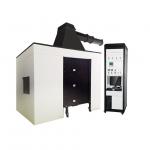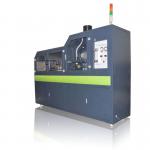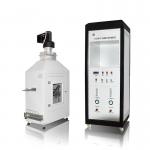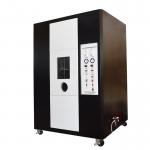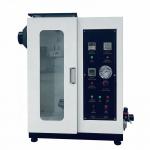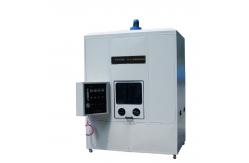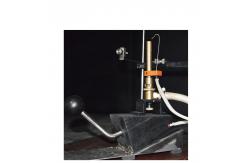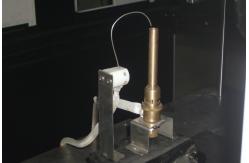In the world of wire and cable manufacturing and fire safety
assessment, the Large Combustion Chamber / Wire and Cable
Flammability Testing Equipment stands as a vital tool. It is
engineered to meticulously evaluate the flammability
characteristics of wires and cables under diverse and controlled
conditions, thereby playing a crucial role in ensuring the safety
and reliability of electrical installations. The Large Combustion Chamber / Wire and Cable Flammability Testing
Equipment is a specialized apparatus designed to conduct
comprehensive flammability tests on wires and cables. It is an
essential asset in wire and cable production facilities, quality
control laboratories, and research institutions. By subjecting wire
and cable specimens to a precisely regulated combustion environment
and monitoring key parameters such as flame spread rate, smoke
generation, and combustion time, it determines the fire resistance
capabilities of these electrical conductors. This data is
indispensable for manufacturers to develop and improve their
products, for regulatory bodies to enforce safety standards, and
for end-users to make informed decisions regarding the installation
and use of wires and cables in various applications, ranging from
residential and commercial buildings to industrial complexes and
critical infrastructure. - Spacious and Durable Combustion Chamber
- The large combustion chamber is constructed from high-grade
refractory materials and robust steel frames. It offers a generous
interior space that can accommodate long lengths and large
diameters of wire and cable samples. The chamber walls are
engineered to withstand extremely high temperatures and thermal
stresses, ensuring a stable and consistent testing environment. The
interior surface is smooth and non-combustible, minimizing any
potential interference with the combustion process of the samples.
- The chamber is equipped with a precisely calibrated ventilation
system. This allows for the control of air flow rates and oxygen
supply, simulating different real-world fire scenarios. The
adjustable vents enable operators to regulate the intensity of the
combustion and study the impact of varying oxygen levels on the
flammability of the wires and cables.
- Precision Ignition and Measurement Systems
- The equipment features a highly reliable ignition source. It can be
a gas burner with adjustable flame characteristics or an electric
ignition device. The ignition system is calibrated to provide a
consistent and reproducible flame, with precise control over flame
height, temperature, and heat flux. For example, the flame height
can be set within a specific range, typically from a few
centimeters to over a dozen centimeters, depending on the test
requirements.
- The measurement suite includes advanced sensors and data
acquisition systems. It can accurately measure the flame spread
rate along the wire or cable, which is calculated based on the time
it takes for the flame to travel a defined distance. Smoke
production is monitored using optical density sensors, providing
quantitative data on the amount of smoke generated during
combustion. The combustion time, from ignition to self-extinction
or a predetermined end point, is precisely recorded. These
measurements are continuously logged and can be analyzed in
real-time or post-test to generate detailed reports and graphs.
- Safety and Environmental Protection Mechanisms
- The Large Combustion Chamber is equipped with multiple safety
features to protect operators and the surrounding environment. It
has a fail-safe gas shut-off valve that immediately stops the gas
supply in case of any abnormal combustion or system malfunction.
The chamber is enclosed with a heat-resistant and explosion-proof
casing, preventing the escape of flames, hot gases, or debris.
- The equipment also incorporates measures to minimize environmental
impact. It is designed to capture and treat any harmful by-products
of combustion, such as toxic gases and particulate matter. This
ensures that the testing process complies with environmental
regulations and reduces the emission of pollutants into the
atmosphere.
| Test chamber volume | 4.32 m³ | | Color - Outside | Square steel frame structure, thickened 1.5mm steel plate with
static baking white paint | | Color - Inside | Electrostatic baking black paint | | Observation window | Tempered glass, surrounded by SUS304 stainless steel, size: 500 *
400 mm | | Operation window | 2 windows, total peripheral size Ф160 mm, outer 3.0 mm stainless
steel edging, sealed with long-arm leather gloves (length: 600 mm)
(length: 600 mm) | | Exhaust system - Fan | Using a centrifugal fan to strongly exhaust the wind | | Exhaust system - Sealed push-pull plate | 2.0 mm stainless steel | | Exhaust system - Sliding grooves | With sliding grooves on both sides | | Air inlet | 4 inlets, size: 200 * 100 mm, sealed push-pull plates are 2.0 mm
stainless steel plates, with sliding grooves on both sides | | Bottom fixing frame | Size: 2.1(L) * 1.16(W) * 0.6(H)m, using 40 * 40 mm square pass,
static baking white paint, with 4 3-inch casters (2 with brakes and
2 without brakes) | | Lighting equipment | Use of anti-fog and smoke incandescent lamps | | Flame time | 0 - 99.99 seconds arbitrarily set | | Flameout time | 0 - 99.99 seconds arbitrarily set | | Flame times | 0 - 999999 times arbitrary setting | | Automation | Automatic ignition, automatic timing, counting function, high test
accuracy | | Dimensions | L2100 * W1630 * H2800 mm | | Working power | AC220V, 50HZ |
- Accurate Flammability Assessment
- The primary function of the Large Combustion Chamber / Wire and
Cable Flammability Testing Equipment is to provide a detailed and
accurate evaluation of the flammability of wires and cables. By
precisely measuring parameters like flame spread rate, smoke
generation, and combustion time, it determines the level of fire
hazard associated with a particular wire or cable product. This
information is crucial for manufacturers to identify areas for
improvement in their designs and materials. For example, if a wire
has a high flame spread rate, the manufacturer can explore
different insulation materials or conductor coatings to enhance its
fire resistance.
- The measurement of smoke production is also of great significance.
Excessive smoke can impede visibility and evacuation in the event
of a fire, and can also contain toxic substances. By quantifying
smoke generation, manufacturers can develop wires and cables that
produce less smoke or have improved smoke suppression properties.
- Compliance with Safety Standards and Regulations
- The wire and cable industry is subject to a multitude of safety
standards and regulations. This testing equipment is a reliable
means for ensuring compliance. It enables manufacturers to conduct
tests in accordance with international and national standards such
as IEC (International Electrotechnical Commission) and UL
(Underwriters Laboratories) standards. By using this equipment and
obtaining accurate test results, manufacturers can prove that their
products meet the required safety levels, facilitating market
access and enhancing consumer confidence.
- Regulatory bodies rely on the test data generated by this equipment
to enforce safety regulations. Inspectors can use the results to
determine whether a particular wire or cable product is suitable
for use in different applications. For example, in high-rise
buildings or in areas with a high fire risk, only wires and cables
that pass strict flammability tests are permitted to be installed.
- Research and Development Support
- In the field of wire and cable research and development, the Large
Combustion Chamber is an invaluable asset. It allows engineers and
scientists to study the effects of different materials, designs,
and manufacturing processes on the flammability of wires and
cables. For instance, they can test the performance of new
flame-retardant additives in insulation materials or evaluate the
impact of cable construction techniques on fire resistance.
- The detailed data obtained from the testing equipment serves as a
roadmap for innovation. It helps researchers to optimize wire and
cable designs, select more suitable materials, and develop new
fire-resistant technologies. This, in turn, leads to the production
of safer and more reliable wires and cables for a wide range of
applications.
- Stringent Manufacturing Process
- The Large Combustion Chamber / Wire and Cable Flammability Testing
Equipment is manufactured under strict quality control procedures.
Each component is carefully sourced and inspected for quality and
performance. The assembly process is carried out by highly trained
technicians in a clean and controlled environment, ensuring the
proper alignment and functionality of all parts.
- The calibration of the ignition system, sensors, and measurement
systems is a critical and regular part of the manufacturing
process. It is performed using traceable reference standards to
guarantee the accuracy and reproducibility of the test results.
Rigorous quality audits and inspections are conducted at various
stages of production to maintain the highest level of product
quality.
- Quality Certification and Validation
Our testing equipment has obtained relevant quality certifications
and has been validated by independent testing laboratories. It has
been proven to provide accurate and reliable test results,
conforming to the relevant international and national safety and
performance standards. We also continuously update and improve our
product based on the latest technological advancements and customer
feedback to ensure its long-term performance and compliance.
- Wire and Cable Manufacturing
- A leading wire and cable manufacturer used the Large Combustion
Chamber to develop a new line of low-smoke and fire-resistant
cables. The test results showed that the new cables had a
significantly reduced smoke generation and flame spread rate
compared to their previous models. This enabled them to market the
cables as a premium fire-safe option, meeting the increasing demand
for such products in the construction and transportation
industries. The company experienced an increase in sales and
enhanced its reputation in the market.
- A manufacturer of specialty cables for the aerospace industry
utilized the equipment to optimize the fire performance of their
products. By testing different combinations of conductors and
insulation materials under extreme conditions, they were able to
develop cables that could withstand the high temperatures and fire
hazards associated with aerospace applications, ensuring the safety
and reliability of aircraft electrical systems.
|
